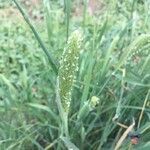Annual, caespitose. Culms (7–) 10–100 cm high, (2–) 4–6-noded. Young shoots intravaginal. Leaves: basal sheaths often purple; ligule entire; blades 3–33 cm long, 2–10 mm wide. Panicles spike-like, 2–10 cm long, cylindrical or often tapered toward base, uninterrupted. Spikelets in groups, usually with 6 sterile spikelets or sterile branches clustered about 1 bisexual spikelet. Glumes of bisexual spikelet equal or subequal, (5–) 6–7.7 (–8.5) mm long, with conspicuous keel-wing appearing as a prominent tooth extending from middle of glume, 5 (–7)-nerved with 3 main nerves, glabrous or sparsely hairy, scaberulous towards apex of midnerve; glumes in sterile spikelets very variable, mostly 3–6.5 mm long, the keel wing usually with a less pronounced tooth or ± erose towards an abruptly tapered or truncated apex (sometimes reduced to swellings at apex of pedicel). Sterile lemmas of bisexual spikelet reduced to scale-like projections 0.2–0.4 (–0.5) mm long. Bisexual floret glossy and pale brown at maturity; lemma 2.5–3.5 mm long, obtuse, indurated, ± glabrous with isolated fine hairs towards apex; palea with few hairs towards apex; anthers 1.1–1.8 mm long; styles basally fused.
Annual, tufted. Culms 15–100 cm tall. Uppermost leaf sheath inflated; leaf blades 2–9 mm wide; ligule 2–8 mm. Panicle dense, narrowly oblong, 4–10 cm, base enclosed in uppermost leaf sheath. Spikelets arranged in clusters composed of 1 fertile spikelet encircled by 6 sterile spikelets, clusters falling entire, sterile spikelets sometimes reduced to club-shaped clusters of glumes. Fertile spikelet: glumes 4.5–6 mm, prominently 7–9-veined, narrowly winged, wing expanded near middle into large tooth, pale green or straw-colored with dark green stripe above tooth, apex attenuate; sterile lemmas abortive, represented by 2 minute fleshy scales at base of fertile lemma; fertile lemma elliptic, 2.8–3.2 mm, cartilaginous, shiny, sparsely pilose toward apex. Anthers 1–1.8 mm. 2n = 14.
Tufted annual 200-1000 mm high; culms fascicled, erect or geniculately ascending. Leaf blade 50-300 x 2-6 mm. Inflorescence to 90 x 20 mm, often enclosed in an inflated leaf sheath; spikelets borne and falling in units of 6 or 7, one fertile surrounded by 5 or 6 sterile spikelets. Sterile spikelet 2.0-6.5 mm long, but often reduced to a clavate knob; glumes 2.0-6.5 mm long, pale green with dark green longitudinal stripes; sterile floret reduced, 0.1-0.2 mm long. Fertile spikelet 5.5-8.2 mm long; glumes 5.5-8.2 mm long, pale green with dark green longitudinal stripes, winged, wings lobed or toothed; anther 1.0-1.5 mm long.
Annual, tufted (culms fascicled, erect or geniculately ascending), up to 0.6 m high. Leaf blades 50-300 mm long, 2-6 mm wide. Spikelets 5.5-8.2 mm long. Panicle 20-70 mm long, 10-25 mm wide, often enclosed in an inflated leaf sheath; spikelets borne and falling in units of 6 or 7 with 1 female-fertile spikelet surrounded by 5 or 6 sterile spikelets, often reduced to clavate knobs; female-fertile spikelets with reduced sterile florets.

